Anatomy of a tender
- Details
A consortium of local authority legal departments in Surrey recently ran a tender for a legal services procurement framework. In this showcase, Improvement and Efficiency South East examines what it entailed and outlines the lessons learned.
Legal Services in Surrey
The Surrey sub-region in the South East, consisting of 12 authorities in total (one county council and 11 borough and district councils), have recently put in place a framework agreement for the provision of Legal Services. The collaborative approach of putting in place a framework agreement for the whole Surrey region has saved individual councils’ staff time and is expected to deliver around 10% savings in cashable savings over the 4 year duration of the contract, equating to an estimated £1m.
Introduction
Towards the end of 2008, a consortium agreement was signed by the 12 Surrey councils to collaborate on the procurement of legal services. Legal Services was previously bought by all the individual councils separately and it was recognised that a collaborative approach would not only save many councils time, it was also seen as a good opportunity to achieve cashable savings across Surrey.
Although several collaborative initiatives – referred to as collaborative procurement Hubs – exist in Surrey, or were in their scoping or inception phase, these do not cover all the authorities and it was recognised that the spend on Legal Services was (a) relatively common across Surrey – even though each of the county, borough and district councils had some work areas unique to them, and (b) a high proportion of authorities’ expenditure profiles. It was hence decided to work together across Surrey to achieve savings and other benefits for the region as a whole.
In the initial stages a project team was established and the county council was selected as formal project lead and legal entity to actually sign the framework agreement on behalf of all councils involved.
The core project group consisted of six representatives across Surrey and involved four legal specialists from both county and boroughs and Districts and two procurement specialists. After needs were assessed and briefings were held for councils and interested suppliers, IESE was asked to support the process with advice and guidance where required and in that role became member of the project team.
From the outset it was agreed by all councils involved that the contract would be a non-exclusive contract to maintain flexibility (which could be required for occasional specialist cases) and keep all stakeholders on board.
Although the market could not be offered a guaranteed expenditure, the following brought confidence to the market: (a) a clear formal commitment by the parties involved to use the framework as a first port of call; (b) appointments outside the framework agreement can only be made after a formal internal approval process within the participating councils; and (c) that uptake would be monitored and if so needed would be questioned in cases of low uptake.
The Process
The full procurement process, including getting all the councils on board, signing the consortium agreement, determining the need and specifications, through to the operational procurement stages and agreeing the actual contract, took around 11 months and the contract formally went live on 1 November 2009. The steps below mark the key activities that were undertaken during the total procurement process.
- Gaining all councils buy-in and signing of agreement.
- Appoint project group and lead authority
- Write project plan and agree timescales (also includes decision to use e-procurement facility).
- Assessment of need in more detail, including legal advice needed for: work areas common to all, areas unique to the county council, areas unique to boroughs and districts, and current estimate of total spend per annum.
- Invite potential and interested suppliers for a briefing and Q&A
- Finalise brief and specifications.
- Finalise PQQ and evaluation methodology
- Send out notification with requests for, expressions of interest and following send out the PQQs.
- Evaluate returned PQQs, select successful bidders and notify (and clarify where required).
- Send out Invitation to Tender (ITT)
- Evaluate ITT, select successful bidders, notify and do clarifications.
- Award contract
- Communications to all councils.
- Launch day for suppliers and councils, including networking,
- Q&A.
- Management of the contract.
The Benefits
Firstly, one very important benefit of the collaborative approach to procuring legal services is the achievement of cashable efficiencies. Councils in Surrey are – like the rest of the UK Councils – under increasing pressure to save money and the collaborative approach by Surrey is answering to this pressure. A cashable saving of 10% is expected to be achieved compared against current costs of the services. This 10% is a forecasted estimate for the life of the contract (four years), equating to around £1m.
Secondly, non-cashable efficiencies have also been achieved by preventing all councils from having to spend resources (staff time) on tendering independently. Although this has been difficult to quantify and although the project group may have spent more time on evaluating the tenders than they would have done if they had done it separately for themselves, it saved the councils collectively time and money.
Thirdly, the concept of all councils in Surrey entering into a consortium agreement to work together using a partnering initiative is innovative and exciting and is likely to encourage other projects to follow a similar route. The project team members knew each other, but they did not necessarily have experience in working with each other on such a project. Although, they may had to get used to each other’s way of working and sometimes a middle ground solution had to be chosen to move the project further, it is expected that the experiences of the legal services tender will aid collaboration in the future around legal services but certainly also other areas of expenditure. This refers to the concept that a collaborative culture and getting used to each other’s way of working needs time to develop and mature.
Fourthly, although the savings are important, the project did not only focus on price but as a very important element it also considered the quality of the service to be provided. The collaborative effort aims to achieve an improved service by the providers which has already been evidenced by the offerings of additional services such as free training opportunities delivered by the providers.
Fifthly, the collaboration does not intend to stop when the contract is in place and hence an added benefit of the collaborative approach is that is simplifies the sharing of experiences between councils about cases and providers. As there are fewer suppliers to manage overall than before, and as this will be done on a collective basis, it will enable Surrey as a collective to work better with the providers to improve the supplier relationships and how these providers (the legal firms and sets of chambers) and clients (the councils) work with each other.
Finally, another common expense of legal departments across Surrey concerns training. An add-on to their service that a significant number of the successful bidders included is the provision of free training to the participating councils’ legal staff and other interested stakeholders. This training will be co-ordinated by the Surrey Administrators and Solicitors’ Group and will have the benefits of forging relationships with the suppliers, networking across districts/boroughs/county and realise cashable savings on our training budgets.
The Lessons Learned
This section reflects on the Surrey collaborative project, summarising the lessons learned during the project, including what worked well for Surrey.
Stakeholder management & planning
1. It is important to gain CEX and Director level commitment and agreement to ensure a smooth process and to promote the actual usage of the framework.
2. Engage with and involve Procurement at the start of the whole process to ensure joint ownership of the process, achieve a smooth transition between phases, and limit information gaps or hold-ups around key decisions for moving to next phases.
3. Put enough time aside for preparation of the tender and evaluations. Rushing the writing of specifications and agreeing evaluation criteria and methods leads to time loss later on in the process.
4. Build some contingency time into the timeline (see endnote 1).
5. Having a suppliers’ day to outline the intentions and provide a chance for feedback and questions prior to the tendering process will give a better preparation for both councils and suppliers.
Specification and preparation
6. Be clear and up front about the possible total expenditure to gain the interest of the supply market and if possible, specify the expenditure per specialised work area that suppliers can bid for. Obtain figures from each participant on their spending for the services in the last three years so that all parties involved are clear on the value of the contract and once the contract is in place accurate assessments can be made of the savings achieved.
7. Good and clear guidance notes and standard templates are needed to limit confusion and ensure every bidder provides the same information. Ensure that when the submissions are made electronically, it is clearly stated where the bidders should attach required documents.
8. Insert as an explicit requirement in the specification that suppliers are expected to help councils deliver efficiency savings.
Evaluation preparation
9. Be clear and up-front about the criteria used to score any open questions that are asked as part of the PQQ and/or ITT stage (i.e. ask yourself what would form the basis for the scoring, or what would bidders not get any points for?).
10. Be clear about the process for evaluation up-front and agree between parties how it will be done (electronically or through a panel and if the latter, how do you organise this).
11. Be clear about the use and evaluation of the pricing schedule (e.g. day rate or otherwise + different levels of quality/expertise, which is specifically pertinent with services such as legal and consultancy). For example, one could use weighting and weighted average scores, but it is important that you get one standard variable that you can compare bids on. (See also footnotes 3 and 4 for some additional information).
12. Think about how total costs and for example how often travel etc will take place and be clear on whether or not to accept additional costs as part of the pricing structure from bidders (e.g. travel and copying costs, etc). Also be clear about whether or not to have quotes inclusive or exclusive of expenses and VAT to ensure a level playing field and ease the evaluation process.
13. Be clear about what to do with late submissions (e.g. not accepting after 24hrs late, or what happens in cases beyond someone’s control such as faulty printers, etc…).
14. Be clear and agree up front the process and level of detail required in feedback and clarifications to bidders that were rejected and/or successful.
Evaluation
15. If a panel evaluates PQQs and/or ITTs and each member evaluates a number of returned PQQs and/or ITTs (e.g. if questions cannot be divided easily for panel members to evaluate just a number of questions), having an independent expert to check scoring and prevent bias can be a useful way to ensure non-discriminatory scoring – this expert however does not score but questions scores and can suggest a second opinion. This can be particularly helpful if it concerns responses to open questions and questions that are evaluated through a rating system (and not pass-fail type questions). In addition, doing a few test evaluations as a group to get everybody familiar with the process and use of criteria is helpful and helps to reduce bias and inequality in evaluations.
16. Make sure that if clarifications are required that as much as possible “non-leading” questions are asked: e.g. what is your point on question X, can you please clarify?
17. Assess whether there is a question that could disqualify the returned PQQs bid and start with this to reject these.
18. As much as possible, document the process of evaluation of each evaluated bid and PQQ by using an agreed scoring sheet showing panel comments to ensure transparency and to provide the ability to respond to any queries quickly and accurately.
19. Having the right number of people to go through the PQQs affects the speed in which you can do this. Surrey had five people going through in excess of 110 PQQs in two days. This was stretching it a bit and an additional meeting had to be held to finalise the evaluations in time.
Contract management
20. Set up an analysis and reporting mechanism for monitoring the use of the Framework and the costs savings achieved.
21. Set up a representative contract management group that meets frequently after the contract has been let to discuss performance, council uptake and other issues. Having a formal internal process for participants (having to have formal sign-off to buy off-contract) helps towards dealing with non-compliance. In addition, it can help to “block” or “remove” existing legal service suppliers that are not on the framework from the finance system, as this can help highlight/warn when an off-contract appointment is being or has been made (as they will need to be set up on the system to be paid). This can then be followed up easier by the contract management team and/or internal procurement officers .
22. Set up a mechanism for capturing and then organising training, secondment and networking opportunities that resulted from the Framework, including analysis of the costs savings for each participant in terms of their training and recruitment budgets.
Discussion points – things to consider
During the tender exercise in Surrey, several discussions took place on some of the details. Albeit that the Surrey project was deemed a successful collaboration, the below points are raised for consideration for anyone thinking about carrying out a similar project. Below is a summary of some of the key points that were discussed.
Number of Service/Work areas
There were different views as to how far the specification should go in terms of detailing the work areas for which suppliers could bid.
Surrey opted for listing the main service areas that resemble legal advice areas, in their case 19: Civil litigation; Commercial, Contract & Procurement; Construction; Employment; Environmental; Local Government advice; Information law & IT law; Support to the Monitoring Officer; Planning; Property; Prosecutions + only for the county council: Adult services; Children’s services; Education; Highways + only for the district councils: Environmental health; Housing; Leisure; Licensing.
For example, in the East Midlands a group of authorities that tendered for legal services together chose to request from providers to cover all areas to minimise contract management and take advantage of economies of scale whereas another cluster in the South East opted for a higher number of areas.
Questions are to be asked about benefits, disadvantages and risks, and is the expenditure in an area big enough to warrant it as a separate work area, or can it be covered elsewhere? Also, instead of describing work areas in terms of specialism or application area (as above), one could consider defining the different functional services that are being delivered to allow for using barristers/chambers and law firms where this is most appropriate This can help ensure both type of firms will be able to deliver and one would have to ensure to reflect this in different requirements regarding insurance levels (see also below).
Another consideration could be tendering for a “managed service” type arrangement where one or a few providers (either large firms covering all areas or consortia of bidders) can provide the full range, which reduces the variety of supplier relations that need to be managed (which could possibly require allowing for sub-contracting to cover specialisms). In all of the above, it is crucial to be clear about categories, sub-categories and definitions to describe them.
Number of suppliers per work area requested
Surrey specified a number of work areas for which it wanted to invite suppliers to bid. In general, criteria are there to be used to limit the number of providers but as there do not appear hard and fast rules about stating a required number, some discussion took place as to if and how to specify a number of suppliers.
There are examples where a minimum is stated, but that means you will have to appoint a minimum number – even if the last one might not be very good in service quality or otherwise. Surrey, however, stated an “envisaged maximum”, which gave the flexibility to appoint less or even one more if say the numbers three and four had an overall score that was very close. By stating a number of providers it is advisable to consider the spend in an area to prevent ending up with too large a number of providers if the spend area is very small (and hence could impact on suppliers’ eagerness to bid).
Finally, to prevent having to discard a number of high quality providers from the PQQ stage (in particular if the end scores are not very dissimilar), one could add a statement such as “the total number of providers per lot may be more according to the complexity of the requirement and the number of bidders meeting the selection criteria”.
Insurance requirements
The level of the suppliers’ required Personal Liability insurance cover was the subject of discussion. E.g. should it be £5m or more than this? Surrey chose £5m as a minimum, which was in line with Surrey County Council’s Procurement Standing Orders (PSO) and was also used by others.
It is important to determine the correct level of insurance for your organisation and your contract. A possible consideration to be taken into account here could be the extent to which the level that is chosen can affect the supply market that can respond.
Although specifications will also have an influence (e.g. if wanting bidders to provide a range of legal service expertise area), a high minimum level of insurance cover could exclude smaller firms such as barristers and chambers, as they do not always have the minimum cover requested.
As insurance requirements are risk related, this could mean that for smaller, lower risk cases, one could be paying more than possibly necessary. Apart from what has been mentioned above with regards to specification of services, an alternative when specifying work areas could be asking for what bidders’ normal cover is and whether they are willing to upgrade if necessary (including the question to specify costs of this). This way, one would minimise paying for more cover when not necessary and could enable taking advantage of using smaller firms where possible.
Endnotes
- Although Legal Services are a Part B Service, the procurement still needs to be run in the spirit of the EU regulations and as such EU minimum timelines were used in planning the project.
- Work area refers to the work area for which legal services need to be sourced from external providers. Examples are: planning, environmental, social care, construction, employment, etc.
- E.g. in Surrey, bidders came back with day rate and subsequent day rates etc, which complicates evaluations. It is suggested to ask for a day rate – irrespective of whether it is preparation work or not, as it is expected that cost drivers for providers do not change – unless there is travel involved but that tends to be covered elsewhere. If different levels of staff work on a case at different stages, asking for experience levels prices covers this. If the assumption is that there could be discounts the longer the case takes and room is left for providers, it could be assumed that the normal day rate is hence not competitive. In Surrey a work plan will be asked for as part of the contract for every assignment carried out.
- For evaluating prices, an alternative to the “traditional” approach (of using day rates and giving the lowest price 100% and the next lowest a % that is 100 - % of price difference), is a model that uses a pre-determined expected rate to benchmark bids against (e.g. CIPFA offers this as alternative and this is used in Sussex where the Councils just after Surrey also tendered for Legal Services). One of the reasons for using this is not to get skewed overall results if a provider submits a low bid but offers poor low quality. The traditional approach could favour this with the risk that poor quality is provided. However, a counterargument is that the PQQ stage should have deselected any low quality providers and as at any ITT stage, quality tends to get a high weighting and a very poor quality should come to light. Also, in frameworks, a few suppliers tend to be appointed to allow for competition and choice of provider, therewith negating the risk of poor quality of service through offering alternatives. A possible disadvantage to the alternative approach is that one might not take advantage of the best price as it is based on the assumption that prices will vary a lot and that a valid target or benchmark price is known.
- Some appointments outside the contract could – in special occasions – be legitimate (although should be minimised, which should be possible if a good process and need assessment has been made and a comprehensive framework is in place), but at least this way one keeps track of the off-contract appointments/orders and can be used to reduce this to a minimum.
For more information, contact Elmer Bakker at IESE via
A consortium of local authority legal departments in Surrey recently ran a tender for a legal services procurement framework. In this showcase, Improvement and Efficiency South East examines what it entailed and outlines the lessons learned.
Legal Services in Surrey
The Surrey sub-region in the South East, consisting of 12 authorities in total (one county council and 11 borough and district councils), have recently put in place a framework agreement for the provision of Legal Services. The collaborative approach of putting in place a framework agreement for the whole Surrey region has saved individual councils’ staff time and is expected to deliver around 10% savings in cashable savings over the 4 year duration of the contract, equating to an estimated £1m.
Introduction
Towards the end of 2008, a consortium agreement was signed by the 12 Surrey councils to collaborate on the procurement of legal services. Legal Services was previously bought by all the individual councils separately and it was recognised that a collaborative approach would not only save many councils time, it was also seen as a good opportunity to achieve cashable savings across Surrey.
Although several collaborative initiatives – referred to as collaborative procurement Hubs – exist in Surrey, or were in their scoping or inception phase, these do not cover all the authorities and it was recognised that the spend on Legal Services was (a) relatively common across Surrey – even though each of the county, borough and district councils had some work areas unique to them, and (b) a high proportion of authorities’ expenditure profiles. It was hence decided to work together across Surrey to achieve savings and other benefits for the region as a whole.
In the initial stages a project team was established and the county council was selected as formal project lead and legal entity to actually sign the framework agreement on behalf of all councils involved.
The core project group consisted of six representatives across Surrey and involved four legal specialists from both county and boroughs and Districts and two procurement specialists. After needs were assessed and briefings were held for councils and interested suppliers, IESE was asked to support the process with advice and guidance where required and in that role became member of the project team.
From the outset it was agreed by all councils involved that the contract would be a non-exclusive contract to maintain flexibility (which could be required for occasional specialist cases) and keep all stakeholders on board.
Although the market could not be offered a guaranteed expenditure, the following brought confidence to the market: (a) a clear formal commitment by the parties involved to use the framework as a first port of call; (b) appointments outside the framework agreement can only be made after a formal internal approval process within the participating councils; and (c) that uptake would be monitored and if so needed would be questioned in cases of low uptake.
The Process
The full procurement process, including getting all the councils on board, signing the consortium agreement, determining the need and specifications, through to the operational procurement stages and agreeing the actual contract, took around 11 months and the contract formally went live on 1 November 2009. The steps below mark the key activities that were undertaken during the total procurement process.
- Gaining all councils buy-in and signing of agreement.
- Appoint project group and lead authority
- Write project plan and agree timescales (also includes decision to use e-procurement facility).
- Assessment of need in more detail, including legal advice needed for: work areas common to all, areas unique to the county council, areas unique to boroughs and districts, and current estimate of total spend per annum.
- Invite potential and interested suppliers for a briefing and Q&A
- Finalise brief and specifications.
- Finalise PQQ and evaluation methodology
- Send out notification with requests for, expressions of interest and following send out the PQQs.
- Evaluate returned PQQs, select successful bidders and notify (and clarify where required).
- Send out Invitation to Tender (ITT)
- Evaluate ITT, select successful bidders, notify and do clarifications.
- Award contract
- Communications to all councils.
- Launch day for suppliers and councils, including networking,
- Q&A.
- Management of the contract.
The Benefits
Firstly, one very important benefit of the collaborative approach to procuring legal services is the achievement of cashable efficiencies. Councils in Surrey are – like the rest of the UK Councils – under increasing pressure to save money and the collaborative approach by Surrey is answering to this pressure. A cashable saving of 10% is expected to be achieved compared against current costs of the services. This 10% is a forecasted estimate for the life of the contract (four years), equating to around £1m.
Secondly, non-cashable efficiencies have also been achieved by preventing all councils from having to spend resources (staff time) on tendering independently. Although this has been difficult to quantify and although the project group may have spent more time on evaluating the tenders than they would have done if they had done it separately for themselves, it saved the councils collectively time and money.
Thirdly, the concept of all councils in Surrey entering into a consortium agreement to work together using a partnering initiative is innovative and exciting and is likely to encourage other projects to follow a similar route. The project team members knew each other, but they did not necessarily have experience in working with each other on such a project. Although, they may had to get used to each other’s way of working and sometimes a middle ground solution had to be chosen to move the project further, it is expected that the experiences of the legal services tender will aid collaboration in the future around legal services but certainly also other areas of expenditure. This refers to the concept that a collaborative culture and getting used to each other’s way of working needs time to develop and mature.
Fourthly, although the savings are important, the project did not only focus on price but as a very important element it also considered the quality of the service to be provided. The collaborative effort aims to achieve an improved service by the providers which has already been evidenced by the offerings of additional services such as free training opportunities delivered by the providers.
Fifthly, the collaboration does not intend to stop when the contract is in place and hence an added benefit of the collaborative approach is that is simplifies the sharing of experiences between councils about cases and providers. As there are fewer suppliers to manage overall than before, and as this will be done on a collective basis, it will enable Surrey as a collective to work better with the providers to improve the supplier relationships and how these providers (the legal firms and sets of chambers) and clients (the councils) work with each other.
Finally, another common expense of legal departments across Surrey concerns training. An add-on to their service that a significant number of the successful bidders included is the provision of free training to the participating councils’ legal staff and other interested stakeholders. This training will be co-ordinated by the Surrey Administrators and Solicitors’ Group and will have the benefits of forging relationships with the suppliers, networking across districts/boroughs/county and realise cashable savings on our training budgets.
The Lessons Learned
This section reflects on the Surrey collaborative project, summarising the lessons learned during the project, including what worked well for Surrey.
Stakeholder management & planning
1. It is important to gain CEX and Director level commitment and agreement to ensure a smooth process and to promote the actual usage of the framework.
2. Engage with and involve Procurement at the start of the whole process to ensure joint ownership of the process, achieve a smooth transition between phases, and limit information gaps or hold-ups around key decisions for moving to next phases.
3. Put enough time aside for preparation of the tender and evaluations. Rushing the writing of specifications and agreeing evaluation criteria and methods leads to time loss later on in the process.
4. Build some contingency time into the timeline (see endnote 1).
5. Having a suppliers’ day to outline the intentions and provide a chance for feedback and questions prior to the tendering process will give a better preparation for both councils and suppliers.
Specification and preparation
6. Be clear and up front about the possible total expenditure to gain the interest of the supply market and if possible, specify the expenditure per specialised work area that suppliers can bid for. Obtain figures from each participant on their spending for the services in the last three years so that all parties involved are clear on the value of the contract and once the contract is in place accurate assessments can be made of the savings achieved.
7. Good and clear guidance notes and standard templates are needed to limit confusion and ensure every bidder provides the same information. Ensure that when the submissions are made electronically, it is clearly stated where the bidders should attach required documents.
8. Insert as an explicit requirement in the specification that suppliers are expected to help councils deliver efficiency savings.
Evaluation preparation
9. Be clear and up-front about the criteria used to score any open questions that are asked as part of the PQQ and/or ITT stage (i.e. ask yourself what would form the basis for the scoring, or what would bidders not get any points for?).
10. Be clear about the process for evaluation up-front and agree between parties how it will be done (electronically or through a panel and if the latter, how do you organise this).
11. Be clear about the use and evaluation of the pricing schedule (e.g. day rate or otherwise + different levels of quality/expertise, which is specifically pertinent with services such as legal and consultancy). For example, one could use weighting and weighted average scores, but it is important that you get one standard variable that you can compare bids on. (See also footnotes 3 and 4 for some additional information).
12. Think about how total costs and for example how often travel etc will take place and be clear on whether or not to accept additional costs as part of the pricing structure from bidders (e.g. travel and copying costs, etc). Also be clear about whether or not to have quotes inclusive or exclusive of expenses and VAT to ensure a level playing field and ease the evaluation process.
13. Be clear about what to do with late submissions (e.g. not accepting after 24hrs late, or what happens in cases beyond someone’s control such as faulty printers, etc…).
14. Be clear and agree up front the process and level of detail required in feedback and clarifications to bidders that were rejected and/or successful.
Evaluation
15. If a panel evaluates PQQs and/or ITTs and each member evaluates a number of returned PQQs and/or ITTs (e.g. if questions cannot be divided easily for panel members to evaluate just a number of questions), having an independent expert to check scoring and prevent bias can be a useful way to ensure non-discriminatory scoring – this expert however does not score but questions scores and can suggest a second opinion. This can be particularly helpful if it concerns responses to open questions and questions that are evaluated through a rating system (and not pass-fail type questions). In addition, doing a few test evaluations as a group to get everybody familiar with the process and use of criteria is helpful and helps to reduce bias and inequality in evaluations.
16. Make sure that if clarifications are required that as much as possible “non-leading” questions are asked: e.g. what is your point on question X, can you please clarify?
17. Assess whether there is a question that could disqualify the returned PQQs bid and start with this to reject these.
18. As much as possible, document the process of evaluation of each evaluated bid and PQQ by using an agreed scoring sheet showing panel comments to ensure transparency and to provide the ability to respond to any queries quickly and accurately.
19. Having the right number of people to go through the PQQs affects the speed in which you can do this. Surrey had five people going through in excess of 110 PQQs in two days. This was stretching it a bit and an additional meeting had to be held to finalise the evaluations in time.
Contract management
20. Set up an analysis and reporting mechanism for monitoring the use of the Framework and the costs savings achieved.
21. Set up a representative contract management group that meets frequently after the contract has been let to discuss performance, council uptake and other issues. Having a formal internal process for participants (having to have formal sign-off to buy off-contract) helps towards dealing with non-compliance. In addition, it can help to “block” or “remove” existing legal service suppliers that are not on the framework from the finance system, as this can help highlight/warn when an off-contract appointment is being or has been made (as they will need to be set up on the system to be paid). This can then be followed up easier by the contract management team and/or internal procurement officers .
22. Set up a mechanism for capturing and then organising training, secondment and networking opportunities that resulted from the Framework, including analysis of the costs savings for each participant in terms of their training and recruitment budgets.
Discussion points – things to consider
During the tender exercise in Surrey, several discussions took place on some of the details. Albeit that the Surrey project was deemed a successful collaboration, the below points are raised for consideration for anyone thinking about carrying out a similar project. Below is a summary of some of the key points that were discussed.
Number of Service/Work areas
There were different views as to how far the specification should go in terms of detailing the work areas for which suppliers could bid.
Surrey opted for listing the main service areas that resemble legal advice areas, in their case 19: Civil litigation; Commercial, Contract & Procurement; Construction; Employment; Environmental; Local Government advice; Information law & IT law; Support to the Monitoring Officer; Planning; Property; Prosecutions + only for the county council: Adult services; Children’s services; Education; Highways + only for the district councils: Environmental health; Housing; Leisure; Licensing.
For example, in the East Midlands a group of authorities that tendered for legal services together chose to request from providers to cover all areas to minimise contract management and take advantage of economies of scale whereas another cluster in the South East opted for a higher number of areas.
Questions are to be asked about benefits, disadvantages and risks, and is the expenditure in an area big enough to warrant it as a separate work area, or can it be covered elsewhere? Also, instead of describing work areas in terms of specialism or application area (as above), one could consider defining the different functional services that are being delivered to allow for using barristers/chambers and law firms where this is most appropriate This can help ensure both type of firms will be able to deliver and one would have to ensure to reflect this in different requirements regarding insurance levels (see also below).
Another consideration could be tendering for a “managed service” type arrangement where one or a few providers (either large firms covering all areas or consortia of bidders) can provide the full range, which reduces the variety of supplier relations that need to be managed (which could possibly require allowing for sub-contracting to cover specialisms). In all of the above, it is crucial to be clear about categories, sub-categories and definitions to describe them.
Number of suppliers per work area requested
Surrey specified a number of work areas for which it wanted to invite suppliers to bid. In general, criteria are there to be used to limit the number of providers but as there do not appear hard and fast rules about stating a required number, some discussion took place as to if and how to specify a number of suppliers.
There are examples where a minimum is stated, but that means you will have to appoint a minimum number – even if the last one might not be very good in service quality or otherwise. Surrey, however, stated an “envisaged maximum”, which gave the flexibility to appoint less or even one more if say the numbers three and four had an overall score that was very close. By stating a number of providers it is advisable to consider the spend in an area to prevent ending up with too large a number of providers if the spend area is very small (and hence could impact on suppliers’ eagerness to bid).
Finally, to prevent having to discard a number of high quality providers from the PQQ stage (in particular if the end scores are not very dissimilar), one could add a statement such as “the total number of providers per lot may be more according to the complexity of the requirement and the number of bidders meeting the selection criteria”.
Insurance requirements
The level of the suppliers’ required Personal Liability insurance cover was the subject of discussion. E.g. should it be £5m or more than this? Surrey chose £5m as a minimum, which was in line with Surrey County Council’s Procurement Standing Orders (PSO) and was also used by others.
It is important to determine the correct level of insurance for your organisation and your contract. A possible consideration to be taken into account here could be the extent to which the level that is chosen can affect the supply market that can respond.
Although specifications will also have an influence (e.g. if wanting bidders to provide a range of legal service expertise area), a high minimum level of insurance cover could exclude smaller firms such as barristers and chambers, as they do not always have the minimum cover requested.
As insurance requirements are risk related, this could mean that for smaller, lower risk cases, one could be paying more than possibly necessary. Apart from what has been mentioned above with regards to specification of services, an alternative when specifying work areas could be asking for what bidders’ normal cover is and whether they are willing to upgrade if necessary (including the question to specify costs of this). This way, one would minimise paying for more cover when not necessary and could enable taking advantage of using smaller firms where possible.
Endnotes
- Although Legal Services are a Part B Service, the procurement still needs to be run in the spirit of the EU regulations and as such EU minimum timelines were used in planning the project.
- Work area refers to the work area for which legal services need to be sourced from external providers. Examples are: planning, environmental, social care, construction, employment, etc.
- E.g. in Surrey, bidders came back with day rate and subsequent day rates etc, which complicates evaluations. It is suggested to ask for a day rate – irrespective of whether it is preparation work or not, as it is expected that cost drivers for providers do not change – unless there is travel involved but that tends to be covered elsewhere. If different levels of staff work on a case at different stages, asking for experience levels prices covers this. If the assumption is that there could be discounts the longer the case takes and room is left for providers, it could be assumed that the normal day rate is hence not competitive. In Surrey a work plan will be asked for as part of the contract for every assignment carried out.
- For evaluating prices, an alternative to the “traditional” approach (of using day rates and giving the lowest price 100% and the next lowest a % that is 100 - % of price difference), is a model that uses a pre-determined expected rate to benchmark bids against (e.g. CIPFA offers this as alternative and this is used in Sussex where the Councils just after Surrey also tendered for Legal Services). One of the reasons for using this is not to get skewed overall results if a provider submits a low bid but offers poor low quality. The traditional approach could favour this with the risk that poor quality is provided. However, a counterargument is that the PQQ stage should have deselected any low quality providers and as at any ITT stage, quality tends to get a high weighting and a very poor quality should come to light. Also, in frameworks, a few suppliers tend to be appointed to allow for competition and choice of provider, therewith negating the risk of poor quality of service through offering alternatives. A possible disadvantage to the alternative approach is that one might not take advantage of the best price as it is based on the assumption that prices will vary a lot and that a valid target or benchmark price is known.
- Some appointments outside the contract could – in special occasions – be legitimate (although should be minimised, which should be possible if a good process and need assessment has been made and a comprehensive framework is in place), but at least this way one keeps track of the off-contract appointments/orders and can be used to reduce this to a minimum.
For more information, contact Elmer Bakker at IESE via
Antisocial Behaviour Legal Officer
Governance Lawyer
Regulatory/Litigation Lawyer
Legal Adviser
Solicitor/Lawyer (Contracts and Procurement)
Legal Director - Government and Public Sector
Deputy Director Legal and Democratic Services
Lawyer (Planning and Regulatory)
Contracts Lawyer
Solicitor - Litigation
Locum roles
 Masterclass – MCA and Court of Protection - Legal Update - Peter Edwards Law Training
Masterclass – MCA and Court of Protection - Legal Update - Peter Edwards Law Training
21-01-2026
Online (live)
 Managing settlements: the legal and practical issues, and the pitfalls to avoid - Blake Morgan
Managing settlements: the legal and practical issues, and the pitfalls to avoid - Blake Morgan
22-01-2026 10:00 am
Online (live)
 Children and Young People (DoL, Competency and Capacity) - Peter Edwards Law Training
Children and Young People (DoL, Competency and Capacity) - Peter Edwards Law Training
28-01-2026
Online (live)
 HMPL Building Blocks: Legal Tools to Combat Anti-Social Behaviour - Devonshires
HMPL Building Blocks: Legal Tools to Combat Anti-Social Behaviour - Devonshires
17-02-2026
Online (live)
 Freedom of thought, belief and religion: Article 9 ECHR - Francis Taylor Building
Freedom of thought, belief and religion: Article 9 ECHR - Francis Taylor Building
19-02-2026
Online (live)
 Grappling with S73 - variations of conditions applications or appeals - Ivy Legal
Grappling with S73 - variations of conditions applications or appeals - Ivy Legal
09-03-2026
Online (live)
 HMPL Building Blocks: Tenancy Management – Assignment, Mutual Exchange and Succession - Devonshires
HMPL Building Blocks: Tenancy Management – Assignment, Mutual Exchange and Succession - Devonshires
12-03-2026
Online (live)
 Section 31(2A) Senior Courts Act: where have we got to? - Francis Taylor Building
Section 31(2A) Senior Courts Act: where have we got to? - Francis Taylor Building
18-03-2026 1:00 pm
Online (live)
 Save the Date: The Law of Public Rights of Way, Commons and Town or Village Greens Seminar (Hybrid) - Francis Taylor Building
Save the Date: The Law of Public Rights of Way, Commons and Town or Village Greens Seminar (Hybrid) - Francis Taylor Building
25-03-2026
London
 HMPL Building Blocks: A Housing Officer’s Guide to Court Proceedings - Devonshires
HMPL Building Blocks: A Housing Officer’s Guide to Court Proceedings - Devonshires
14-04-2026
Online (live)


















































































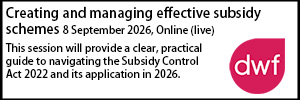




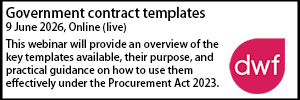

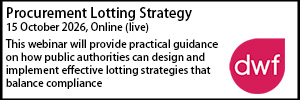





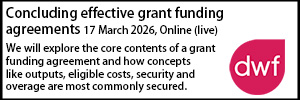








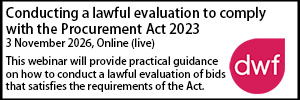
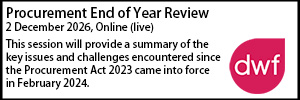
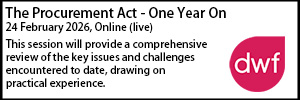



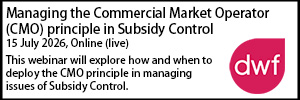



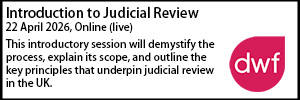





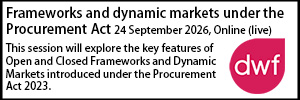

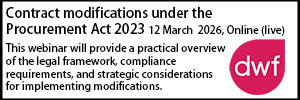
 First Aid Level 3 - LBL Skills
First Aid Level 3 - LBL Skills  Capsticks Housing Diploma
Capsticks Housing Diploma  Standish 18 months on - 42BR
Standish 18 months on - 42BR  Accelerating EV Charging Infrastructure in the Public Sector - DWF
Accelerating EV Charging Infrastructure in the Public Sector - DWF  Building Safety Act Conference 2026 - Landmark Chambers
Building Safety Act Conference 2026 - Landmark Chambers  Education Law Conference - 3PB
Education Law Conference - 3PB  Annual Planning Seminar 2026 - No.5 Barristers
Annual Planning Seminar 2026 - No.5 Barristers 